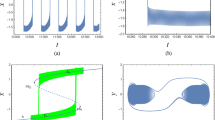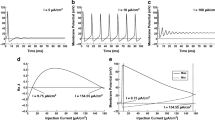Foci of epileptic activity, generated as a result of synchronization of periodic burst discharges in neuronal networks, are often localized in the hippocampus. Using a model approach, we investigated the possibility of and biophysical conditions for the appearance of local oscillatory processes in dendrites possessing voltage-dependent channels (which is typical of pyramidal neurons of the hippocampus). The study was performed on a computer model of the membrane with active conductivities inherent in dendrites of pyramidal neurons of the CA3 area. It was found that such a membrane compartment subjected to tonic synaptic excitatory influences can function as a local generator of stable depolarization of a low or a high level or as a generator producing membrane potential oscillations (local oscillator). Each of these modes corresponds to a certain range of the synaptic excitation intensity; with increasing temperature, the range within which the oscillator properties are manifested is narrowed, while the range within which high-level stable depolarization is generated is expanded.
Similar content being viewed by others
References
M. Rudolph and A. Destexhe, “The discharge variability of neocortical neurons during high-conductance states,” Neuroscience, 119 (3), 855-873 (2003).
S. M. Korogod and S. Tyč-Dumont, Electrical Dynamics of the Dendritic Space, Cambridge Univ. Press, Cambridge (2009).
I. B. Kulagina, A. V. Kaspirzhny, and S. M. Korogod, “Organization of activity of hippocampal pyramidal neurons under coactiavtion of dendritic glutamate-and GABA-sensitive receptors: a simulation study,” Neurophysiology, 46, No. 2, 99-107 (2014).
I. B. Kulagina, S. M. Korogod, G. Horcholle-Bossavitt, et al., “The electro-dynamics of the dendritic space in Purkinje cells of the cerebellum,” Arch. Ital. Biol., 145, Nos. 3/4, 211-233 (2007).
M. W. H. Remme, M. Lengyel, and B. S. Gutkin, “The role of ongoing dendritic oscillations in single-neuron dynamics,” PLoS Comput. Biol., 5, No. 9, e1000493 (2009).
N. T. Carnevale and M. L. Hines, The NEURON Book, Cambridge Univ. Press, Cambridge (2006).
P. Hemond, D. Epstein, A. Boley, et al., “Distinct classes of pyramidal cells exhibit mutually exclusive firing patterns in hippocampal area CA3b,” Hippocampus, 18, No. 4, 411-424 (2008).
R. R. Llinás, “Intrinsic electrical properties of mammalian neurons and CNS function: a historical perspective,” Front. Cell Neurosci., 8, 320 (2014).
A. Das, R. K. Rathour, and R. Narayanan, “Strings on a violin: location dependence of frequency tuning in active dendrites,” Front. Cell Neurosci., 11, 72 (2017).
S. M. Korogod and L. E. Demianenko, “Temperature deactivation of depolarizing TRP-current as a mechanism of neuronal activity inhibition during hypothermia,” Neurophysiology, 48 , Nos. 5/6, 406-414 (2016).
L. E. Demianenko, E. P. Poddubnaya, I. A. Makedonsky, et al., “Hypothermic suppression of epileptiform bursting activity of a hyppocampal granule neuron possessing thermosensitive TRP channels (a model study: biophysical and clinical aspects),” Neurophysiology, 49, No. 1, 8-18 (2017).
D. G. Amaral, “Emerging principles of intrinsic hippocampal organization,” Curr. Opin. Neurobiol., 3, No. 2, 225-229 (1993).
D. A. McCormick and D. Contreras, “On the cellular and network bases of epileptic seizures,” Annu. Rev. Physiol., 63, 815-846 (2001).
R. K. S. Wong, R. Miles, and R. D. Traub, “Local circuit interactions in synchronization of cortical neurones,” J. Exp. Biol., 112, No. 1, 169-178 (1984).
G. K. Motamedi, R. P. Lesser, and S. Vicini, “Therapeutic brain hypothermia, its mechanisms of action, and its prospects as a treatment for epilepsy,” Epilepsia, 54, No. 6, 959-970 (2013).
Author information
Authors and Affiliations
Corresponding author
Rights and permissions
About this article
Cite this article
Kaspirzhnyi, A.V. Local Oscillatory Properties of the Dendritic Membrane of Hippocampal Pyramidal Neurons: a Simulation Study. Neurophysiology 49, 178–182 (2017). https://doi.org/10.1007/s11062-017-9671-5
Received:
Published:
Issue Date:
DOI: https://doi.org/10.1007/s11062-017-9671-5




